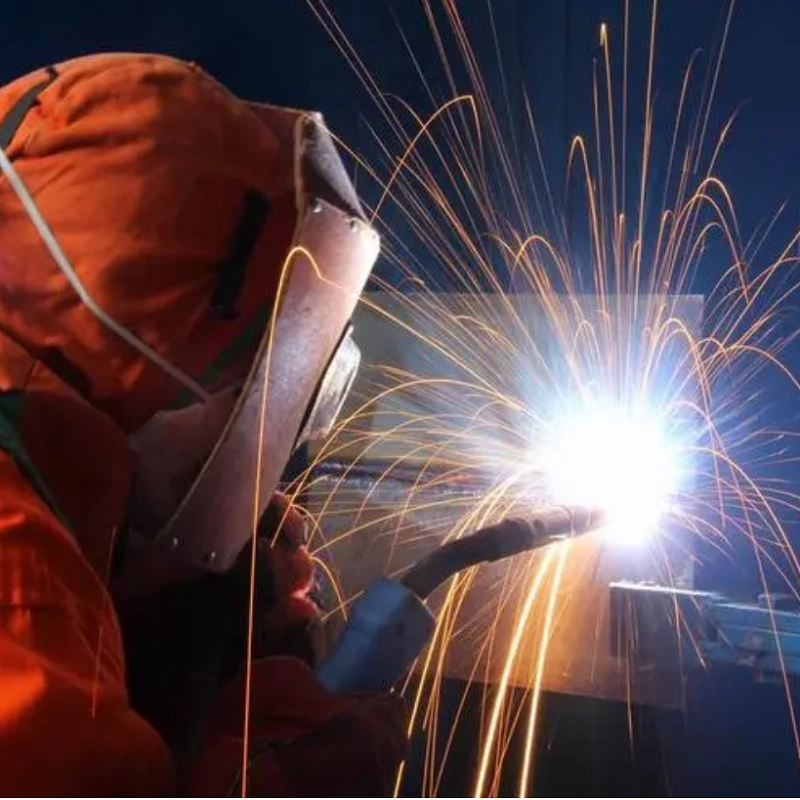# How to Choose the Best Welding Helmet: Your Guide to ANSI Standards, Shade Charts, and Clarity Ratings
When you're about to strike an arc, the welding helmet you're wearing is the single most important piece of safety gear separating you from serious injury. But with so many options, how do you choose the best one? This guide is here to help. We will break down the essential factors you need to consider, from understanding critical safety standards like ANSI Z87.1 to decoding welding helmet shade charts and optical clarity ratings. Whether you're a seasoned professional welder or a procurement manager sourcing equipment for your team, this article will provide the clear, expert insights needed to make a confident and safe choice.
What is the ANSI Z87.1 Standard and Why Does it Matter for Your Welding Helmet?
When you look at a quality welding helmet, you'll often see the marking "ANSI Z87.1". This isn't just a random set of characters; it's your assurance of safety. The ANSI Z87.1 standard, set by the American National Standards Institute, is the primary U.S. standard for occupational eye and face protection. It establishes the criteria for the design, construction, testing, and use of protective eyewear, including welding helmets. For a helmet to earn this rating, it must pass a series of rigorous tests, including high-velocity impact tests, which ensure the shell and lens can protect you from flying debris and a potential spark.
So, why is this so critical when you weld? The welding process creates an environment filled with hazards. A certified ANSI Z87.1 welding helmet guarantees that your eyes and face are protected not just from the intense arc, but also from physical impacts. Furthermore, the standard ensures that the lens provides 100% protection from harmful UV and IR radiation at all times, even in its light state. As a manufacturer, we understand that compliance with these safety standards is non-negotiable. When you see the ANSI Z87.1 mark, you can be confident that the welding helmet provides the industrial-grade protection every welder needs.
How Do I Read and Use a Welding Helmet Shade Chart Correctly?
The shade of your welding helmet's lens is its most critical safety feature for protecting your eyes from the bright, visible light of the weld arc. The darkness of the lens is indicated by a shade number—the higher the number, the darker the lens. Choosing the correct lens shade is essential for both protection and visibility. The best way to do this is by using a welding helmet shade chart. This chart is a simple guide that helps you select the right lens shade based on your specific welding process and the amperage you are using.
To use the chart, first identify your type of welding—such as Shielded Metal Arc Welding (Stick), MIG welding, or TIG welding. Next, determine the amperage you will be using to weld. The chart will then show you the recommended shade number or a small range. For instance, a low-amperage TIG weld might only require a shade 9, while a high-amperage stick welding job could demand a shade 13 or 14. An auto-darkening welding helmet is incredibly useful here, as it allows you to adjustable the shade to match the chart's recommendation for each specific welding task.
Example Welding Helmet Shade Chart
| Welding Process | Amperage (Amps) | Recommended Shade |
|---|---|---|
| Stick (SMAW) | 60A - 160A | 10 |
| MIG (GMAW/FCAW) | 160A - 250A | 11 |
| TIG (GTAW) | 50A - 150A | 10 - 11 |
| Plasma Cutting | 40A - 60A | 9 |
What Happens if I Use the Wrong Lens Shade to Weld?
Using the incorrect lens shade when you weld is a serious mistake with immediate and potentially long-term consequences. It's a risk no welder should ever take. The intense light and radiation from the welding arc can cause significant damage to your eyes if the protection is inadequate.
If you weld with a lens shade that is too light for the job, the arc will be overwhelmingly bright. This will immediately cause eye strain, fatigue, and headaches. More dangerously, it exposes your eyes to excessive radiation, leading to a painful condition known as "arc eye" or photokeratitis. Think of it as a sunburn on your cornea. On the other hand, if you weld with a darker shade than necessary, your visibility will be severely compromised. You won't be able to see clearly the weld puddle, the joint, or your travel angle. This lack of visibility almost always leads to a poor-quality weld, full of defects. The wrong shade can cause eye strain and bad welds, which is why following a welding helmet shade chart is so important.

Auto-Darkening Welding Helmets: Are They Worth the Investment?
For decades, the standard was a fixed shade welding helmet, which required the welder to "nod" the helmet down right before striking the arc. While effective, this method is inefficient and can lead to neck strain and misplaced starts to the weld. Today, auto-darkening welding helmets have become the industry standard for good reason. These modern welding helmets feature a special lens that stays in a light state (usually shade 3 or 4) until the sensors detect the flash of the weld arc. At that moment, the lens darkens to your pre-selected shade in a fraction of a second.
The benefits are enormous. With an auto-darkening lens, your visibility is perfect for setting up your weld, and the helmet can stay in the down position, freeing up your hands and reducing neck strain. This leads to greater accuracy, higher efficiency, and a safer overall weld experience. You no longer have to worry about accidentally flashing yourself while positioning your torch. While the initial cost may be higher than a passive helmet, the gains in productivity and comfort make auto-darkening welding helmets a worthy investment for any serious or professional welding application.
Decoding Optical Clarity Ratings: What Do Those Numbers on the Lens Mean?
When you look at a high-quality auto-darkening lens, you may see a series of four numbers separated by slashes, such as 1/1/1/1 or 1/1/1/2. These are the clarity ratings of the lens, based on the European standard EN 379, and they are a crucial indicator of lens quality. A lower number is better, with '1' being a perfect score. Each number represents a different aspect of optical performance:
- Optical Class (Accuracy of Vision): How distorted the image is when you look through the lens. A '1' rating means the view is crisp and clear, like looking through clean glass.
- Diffusion of Light Class: This rating checks for haziness or cloudiness in the lens from microscopic imperfections in the filter. A '1' rating ensures a clear, haze-free view.
- Variations in Luminous Transmittance Class: This measures the consistency of the shade across the entire lens. A '1' means the shade is uniform, with no random dark or light spots.
- Angle Dependence Class: This rating checks if the shade remains consistent when you view the arc from different angles. A '2' is common here, but a '1' is the best, ensuring you see the same shade even if you're looking at the weld from the side.
A welding helmet with a 1/1/1/1 rating offers the best possible optical clarity, reducing eye strain and giving you the truest view of your weld puddle and the surrounding area. This superior visibility allows for greater precision and control over your weld.
Does the Type of Welding Process Affect My Helmet Choice?
Yes, the specific welding process you use should absolutely influence your choice of welding helmet. Different processes generate different arc intensities and have unique demands. What works perfectly for a heavy-duty stick welding job might not be ideal for delicate TIG welding.
For TIG welding, which often uses very low amperages, you need a welding helmet with excellent sensor sensitivity. The arc from a low-amp TIG weld can be less intense, so a helmet needs to be able to detect it reliably to darken. Helmets with 4 arc sensors are often preferred for TIG. For MIG welding, which is a versatile process, a good all-around auto-darkening helmet with a wide shade range is usually sufficient. For Shielded Metal Arc Welding (Stick) and flux-cored welding, which produce a very bright arc and a lot of smoke and spatter, a durable helmet with a reliable, darker shade capability is essential. Choosing a helmet suited to your primary type of welding process ensures optimal protection and performance.

Beyond the Lens: What Other Features Should a Quality Welding Helmet Have?
While the lens is the heart of the welding helmet, other features play a huge role in the welder's comfort, safety, and productivity. A helmet that is uncomfortable or poorly balanced will lead to fatigue and distraction, which can compromise the quality of your weld.
First, consider the headgear. Look for headgear that is highly adjustable to provide a secure and customized fit. Padded straps and a balanced design help distribute the helmet's weight evenly, preventing neck strain during long weld sessions. The overall weight of the helmet is also important; a lighter helmet will be more comfortable for all-day use. The size of the viewing area is another key consideration. A larger viewing area provides a wider field of vision, which enhances visibility and situational awareness. Finally, the helmet shell should be made from a durable, heat-resistant material that can withstand the rigors of the welding environment.
How Do OSHA and ANSI Work Together to Ensure Welder Safety?
Understanding the relationship between OSHA (Occupational Safety and Health Administration) and ANSI is important for anyone responsible for workplace safety. OSHA is a U.S. government agency that sets and enforces mandatory workplace safety requirements. For welding, OSHA requires that employers provide workers with effective eye and face protection.
However, OSHA doesn't typically create the specific performance standards for equipment. Instead, it often incorporates or references standards developed by independent organizations like ANSI. So, when OSHA mandates eye protection for a welder, it is the ANSI Z87.1 standard that defines what an acceptable and safe welding helmet is. In essence, OSHA tells you that you need to protect your workers, and ANSI provides the detailed blueprint for how that protection should perform. Ensure any welding helmet you purchase for your team meets the ANSI Z87.1 standard to comply with OSHA regulations and provide proven protection.
Why is Regular Inspection and Maintenance of Your Welding Helmet Crucial?
A welding helmet is a durable piece of equipment, but it's not indestructible. To ensure it continues to provide reliable protection every time you weld, regular inspection and maintenance are essential. The harsh environment of a workshop—filled with sparks, spatter, dust, and grime—can take a toll on your helmet.
Before every weld, give your helmet a quick check. Inspect the outer shell for any cracks or damage that could compromise its integrity. Most importantly, check the lenses, both the outer cover lens and the inner auto-darkening lens. The outer cover lens is a sacrificial piece designed to protect the more expensive auto-darkening lens from spatter and scratches. These should be cleaned regularly and replaced as soon as they become too pitted or clouded to see clearly. A scratched or damaged lens impairs visibility and can cause distracting glares. Also, check the sensors on an auto-darkening helmet to ensure they are clean and unobstructed. A few moments of care can significantly extend the life of your helmet and ensure it's always ready to protect you.

How to Choose the Best Helmet for Your Professional Welding Needs?
Choosing the best welding helmet is a matter of matching the helmet's features to your specific welding needs. For a professional welding environment or for a distributor like Mark Thompson sourcing for his clients, the decision should be based on safety, performance, and user comfort. Start by insisting on helmets that meet the ANSI Z87.1 standard—this is your baseline for safety.
Next, an auto-darkening helmet is almost always the superior choice for professional applications due to its efficiency and ease of use. Pay close attention to the optical clarity ratings; a helmet with a 1/1/1/2 or, ideally, a 1/1/1/1 rating will significantly reduce eye strain and improve weld quality. Consider the various welding processes your team will perform and select a helmet with an appropriate shade range and sensor sensitivity. For instance, if you do a lot of low-amp TIG work, a helmet like our Dongtie TIG Welding Protective Mask is specifically designed for that challenge. By focusing on these key performance indicators, you can confidently select the right helmet that provides lasting value and unwavering protection for any welder. As a trusted supplier, we are committed to providing high-quality, fully certified welding helmets that meet these rigorous demands.
Key Takeaways for Choosing Your Welding Helmet:
- Insist on ANSI Z87.1: This standard is your guarantee that the welding helmet meets crucial safety standards for impact and radiation protection.
- Use a Shade Chart: Always select your lens shade based on the welding process and amperage to properly protect your eyes and ensure good visibility.
- Choose Auto-Darkening: For professional use, auto-darkening helmets offer superior efficiency, accuracy, and comfort over traditional fixed shade helmets.
- Don't Ignore Optical Clarity: A high optical clarity rating (like 1/1/1/1) reduces eye strain and allows you to see clearly, leading to better quality welds.
- Match the Helmet to the Weld: Consider the specific demands of your welgding tasks, such as the sensitivity needed for TIG or the durability for stick welding.
- Comfort is Key: Look for a lightweight welding helmet with highly adjustable and comfortable headgear to minimize fatigue during long hours of work.
- Inspect and Maintain: Regularly clean and inspect your welding helmet, especially the lenses, to ensure it always provides optimal protection and clear visibility.






